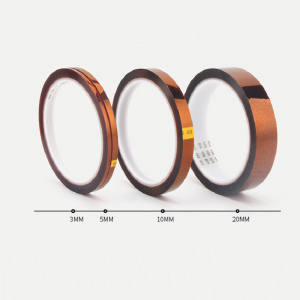Introduction and application of Xinst gold finger high temperature Kapton tape
xinstSep 18, 2021
Gold finger high temperature tape is a special kind of tape. Also known as Kapton tape or polyimide tape, the tape is based on polyimide film, coated with high-performance silicone pressure-sensitive adhesive on one side, and has two types of materials: single-sided fluoroplastic release material composite or non-composite .

Features:
Gold finger kapton tape has the properties of high and low temperature resistance, acid and alkali resistance, electrical insulation, radiation protection, high adhesion, softness, and non-residual adhesive after tearing. When the gold finger tape is torn off after use, there will be no residual glue on the surface of the protected object.
application:
1. Gold finger tape is suitable for the tangled insulation of coils and wires, and the manufacture of electronic products such as capacitors.
2. Printed circuit board gold-plated fingers, hot-air tin hole processing and various stages of shielding protection in the tin furnace.
3. Gold finger tape is also commonly used for coils, transformers, motors, capacitors and wire entanglements, the fixing of the positive and negative ears of lithium batteries, the protection of the heating process of electronic products, and various high-temperature shielding protection.
4. Paint: Used as insulating paint for magnet wire, or as high temperature resistant paint.
5. Advanced composite materials: used in aerospace, aircraft and rocket components. It is one of the most high temperature resistant structural materials.
6. Fiber: The modulus of elasticity is second only to carbon fiber. It is used as a filter material for high-temperature media and radioactive materials and bulletproof and fireproof fabrics.
7. Foam plastic: used as high temperature heat insulation material.
8. Engineering plastics: there are thermosets and thermoplastics. Thermoplastics can be compression molded or injection molded or transfer molded. Mainly used for self-lubricating, sealing, insulating and structural materials.
9. Photoresist: Some polyimides can also be used as photoresist. There are negative glue and positive glue, and the resolution can reach sub-micron level. It can be used in color filter film when combined with pigments or dyes, which can greatly simplify the processing procedures.
10. Application in microelectronic devices: used as a dielectric layer for interlayer insulation, and as a buffer layer to reduce stress and improve yield. As a protective layer, it can reduce the impact of the environment on the device, and it can also shield the a-particles, reducing or eliminating the soft error of the device.


